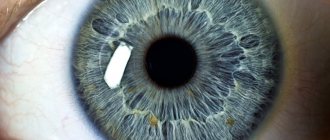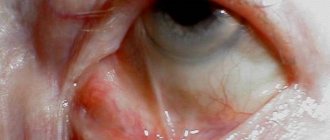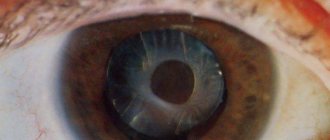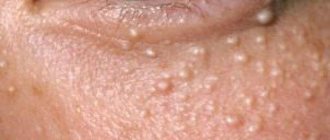Superior orbital fissure syndrome occurs due to damage to the nerve fibers of the pathways or nuclei of the cranial nerves innervating the eyes and its appendages. In this case, the patient’s vision is impaired, oculomotor function and eyelid sensitivity suffer. Treatment consists of eliminating the inflammatory syndrome or removing the tumor.
According to a publication in the scientific journal Ophthalmological Gazette, the symptom of the superior orbital fissure may occur due to a carotid artery aneurysm in the cavernous sinus.
What are the causes and pathogenesis of development?
Superior or inferior orbital fissure syndrome occurs as a result of damage to the main nerves of the eye. In this case, the trochlear, abducens, ocular and oculomotor pathways are not able to transmit nerve impulses to the muscles that are involved in the functioning of the organ of vision. The death of neurons is the result of mechanical damage, neurodegenerative disease, or compression by a neoplasm. Moreover, the main cause of such disorders may be due to damage to the pathways and directly to the nuclei located in the brain or spinal cord.
Symptoms of damage to the superior orbital fissure can be provoked by the following factors on the human body:
Damage to the superior orbital fissure occurs as a result of unsuccessful surgery or orbital trauma.
- autoimmune damage to neurons with the development of multiple sclerosis;
- bacterial infections affecting dura mater tissue;
- neurodegenerative diseases;
- suffered traumatic brain injuries;
- unsuccessful surgical interventions;
- traumatic injuries in the orbital area;
- tumor neoplasms;
- severe liquorodynamic hypertension;
- viral or fungal meningitis.
Diagnosis and treatment of superior orbital fissure syndrome
Superior orbital fissure syndrome is a pathology that is characterized by complete paralysis of the internal and external muscles of the eye and loss of sensitivity of the upper eyelid, cornea, and part of the forehead.
Symptoms may be caused by damage to the cranial nerves. Painful conditions arise as complications of tumors, meningitis and arachnoiditis.
The syndrome is typical for elderly and middle-aged people; this pathology is rarely diagnosed in children.
Anatomy of the apex of the orbit
The orbit, or eye socket, is a paired bony cavity in the skull that is filled with the eyeball and its appendages. Contains structures such as ligaments, blood vessels, muscles, nerves, and lacrimal glands.
The apex of the cavity is its deep zone, bounded by the sphenoid bone, occupying approximately a fifth of the entire orbit.
The boundaries of the deep orbit are outlined by the wing of the main bone, as well as the orbital process of the plate of the palatine bone, the infraorbital nerve and the inferior orbital fissure.
Chapter 1: Toloza-Hunt Syndrome
Book: “Rare neurological syndromes and diseases” (V.V. Ponomarev)
Toloza-Hunt syndrome (STX, synonyms: painful ophthalmoplegia, superior orbital fissure syndrome, cavernous sinus syndrome, Raider paratrigeminal neuralgia) was first described by the Spanish neurologist E. Toloza in 1954 and the English physician W. Hunt in 1961 [5, 14 ] and has been designated by this name since 1966. The etiology of CTX is often associated with the formation of an autoimmune granulomatous inflammatory process of the outer wall of the cavernous sinus, as well as extra- and intracavernous periarteritis [2, 12]. STX has been described in tumors of the brain and orbit, vascular malformations, Wegener's granulomatosis, phlebothrombosis and epidermoid cysts of the cavernous sinus, sarcoidosis, orbital myositis, hypertrophic pachymeningitis, and blood diseases [1, 3, 8, 9, 13].
Neurological manifestations of the disease include symptoms of damage to the four cranial nerves (the first branch of the trigeminal, oculomotor, abducens and trochlear) passing through the cavernous sinus. In the classic version, STX is manifested by pain in the orbit, total ophthalmoplegia and signs of venous congestion in the orbit (exophthalmos and chemosis). Depending on the extent of the process in the wall of the cavernous sinus, the clinical picture of the disease can be complete or incomplete and occur with predominant damage to individual cranial nerves [5, 6, 14]. Involvement of sympathetic and parasympathetic fibers of the pericarotide plexus and oculomotor nerve in the process leads to various reactions of the pupil - such as miosis or mydriasis. With equal involvement of sympathetic and parasympathetic fibers in the process, the pupil may not change. The pathological process is often unilateral, but can be bilateral, recurrent, or alternating. The basis of treatment for STX is the prescription of corticosteroids, which in some cases lead to a marked improvement in the condition of patients [2, 4, 5].
We observed 100 patients with STX (57 men, 43 women, age 15-87 years). Persons of the most working age predominated - 30-60 years (48%). Relatively often, the onset of the disease was observed in old age (37%). In equal proportions (50% each), the disease developed either without warning signs or against the background of previous infections. Patients with subacute or chronic course of STX were more common. In most cases (56%), the disease began with pain in the orbital, frontal or temporal areas. Less commonly (25%), the disease began with diplopia, ptosis, and other oculomotor disorders. After several weeks and months, the clinical picture was complemented by other symptoms of the disease. In 21% of cases, complete STX was observed, and in the remaining patients, partial STX was observed (with damage to individual specified cranial nerves in different combinations). Most often (52%) a combined lesion of the III, IV and I branches of the V pair of cranial nerves was detected. Painless (atypical) variants of STX were noted in 23% of cases. Isolated damage to the VI and III cranial nerves occurred in 4% of cases. Moderate exophthalmos and various signs of venous congestion in the orbit with the formation of chemosis were observed in 26% of patients. In the vast majority of patients, the process was unilateral (96%) and in only 4% it was bilateral, but with obvious asymmetry of the lesion. Long-term follow-up revealed the recurrent nature of the disease in 27% of patients, and in 4% the CTX was of an alternating nature (on the other hand).
During the examination, general tests and biochemical blood tests in a number of cases revealed nonspecific reactivity (slight leukocytosis, the appearance of C-reactive protein). When studying the immune status of the blood in 25 patients, the most significant change (40%) was the activation of indicators of cellular or humoral immunity. Liquorological studies were carried out in 70 patients, of which only 17% of cases revealed protein-cell dissociation (increased protein levels from 0.45 to 1.8 g/l). In two cases, lymphocytic pleocytosis was observed, not exceeding 48 • 106 cells/l. In the fundus of 14 patients, when examined by an ophthalmologist, varying degrees of signs of congestion of the optic discs were noted, and in 27 cases, atherosclerotic or hypertensive changes in the vessels of the retina were found.
CT or MRI of the orbits and brain was performed in 65 patients. Analysis of the results obtained allowed us to identify signs of vascular encephalopathy in 27 cases, which were manifested by external or mixed hydrocephalus and small foci of encephalomalacia. In 6 patients, significant thickening of the internal muscles of the eye was observed, which made it possible to diagnose orbital myositis. In 5 cases, tumors of the orbit and skull base were found (Fig. 10). In one case, an incidental radiological finding was an Arnold-Chiari malformation. The remaining patients had no abnormalities on CT or MRI of the brain. In 24 cases, carotid angiography (CAG) was performed, and in 6 patients arteriovenous aneurysms of the infra- and supraclinoid portion of the internal carotid artery were found (Fig. 11). In one case, thrombosis of the cavernous sinus was diagnosed (Fig. 12).
After establishing the final diagnosis and taking into account contraindications, 83 patients received a course of corticosteroid therapy (prednisolone at a dose of 40-80 mg according to an alternating regimen). The duration of treatment was determined by clinical indications and usually ranged from 1.5 to 3 months. Moderate and significant improvement was noted in the vast majority of patients (88%). The effect was not achieved in 12 patients (usually with a long course and late recognition of the disease). Analysis of our own observations indicated a significant number of diagnostic errors before admission to the hospital. At the prehospital stage, the correct diagnosis was established (or suspected) in only 28% of patients. The remaining patients were subjected to additional unnecessary examinations and received inadequate treatment.
Puc. 10. MRI of the brain of patient S., 31 years old, with a diagnosis of STX: a tumor (meningioma) of the wing of the sphenoid bone was revealed (indicated by an arrow)
Rice. 11. CAG of patient K., 65 years old, diagnosed with STX: a giant (3 cm in diameter) aneurysm of the supraclinoid part of the internal carotid artery is determined
Rice. 12. MRI of the brain of patient S., 72 years old, diagnosed with STX: a significant increase in the diameter of the internal vein of the left eye was detected (residual phenomena of phlebothrombosis of the cavernous sinus)
We present one of the observations of late diagnosis of the disease.
Patient P., 48 years old, a teacher, was first admitted to the 2nd neurological department of the 5th clinical hospital in Minsk in 1996. Upon admission, he complained of severe, “burning” pain in the left orbit and frontal region, diplopia when looking into the all sides, feeling of bulging of the left eyeball, redness of the left eye. He was ill for 3 months when, for no apparent reason, pain appeared in the left orbit, and then double vision to the left and drooping of the upper eyelid. He was treated at his place of residence with a diagnosis of basilar arachnoiditis. The ongoing anti-inflammatory therapy had no effect. The neurological status at the first admission was determined by ptosis on the left, convergent strabismus OS, lack of movement of the left eyeball in all directions, anisocoria S>D. In addition, the patient had severe pain on palpation at the exit point of the first branch of the left trigeminal nerve and mild hypoesthesia in this area, moderate exophthalmos of the left eye due to periorbital edema and injection of the sclera. There were no paresis of the limbs, meningeal signs, or cerebellar symptoms.
During the examination: general clinical and biochemical blood tests without pathology. The fundus is normal. CSF: protein 0.2 g/l, cytosis 12 • 106 cells/l (100% lymphocytes). CT scan of the brain: dilation of the ventricular system and smoothing of the sulci of the hemispheres were detected. CAG on the left did not reveal any pathology.
Left Toloza-Hunt syndrome was diagnosed. Prednisolone was prescribed at a dose of 60 mg/day every other day according to an alternating regimen in combination with potassium supplements and veroshpiron. There was a significant improvement, disappearance of pain, and complete restoration of oculomotor disorders. 2 months after the gradual withdrawal of prednisolone due to hypothermia, a relapse was observed in the form of renewed pain and slight drooping of the upper eyelid on the left without oculomotor disorders. A repeated course of corticosteroids was administered at the same dose with improvement. 4 years after the respiratory infection, a third relapse of the disease with similar neurological symptoms occurred, which was stopped by prescribing prednisolone at a dose of 80 mg/day.
Thus, the patient clinically had damage to the III, IV, VI and I branches of the V pair of cranial nerves, moderate chemosis and exophthalmos. This combination of neurological symptoms made it possible to localize the pathological process in the anterior space of the cavernous sinus. When examining the patient, other causes of the disease were excluded. The nature of the clinical picture, recurrent course, and positive results of immunosuppressive therapy suggested the autoimmune nature of CTX. The presented observation is significant from several points of view. Despite the classic clinical picture of CTX, the patient was observed and treated with a diagnosis of arachnoiditis. Corticosteroid therapy resulted in significant improvement. However, during follow-up observation of the patient, two relapses of the disease were revealed in the form of partial STX on the same side, which in one case was probably associated with a rapid reduction in the dose of prednisolone.
The neurological symptoms observed with STX are clearly related to the topical level of localization of the pathological process at the level of the cavernous sinus adjacent to the superior orbital fissure. The pain syndrome in this disease is caused by irritation of the first branch of the trigeminal nerve, which runs next to the trunk of the oculomotor nerve. The localization of pain may vary: orbit, forehead, temple, root of the nose. The intensity of pain has a wide range - from minimal to severe. Atypical (painless) variants of STX associated with the localization of the pathological process before entering the cavernous sinus should be taken into account. In relation to the sinus, anterior, middle and posterior variants of STX are distinguished [1]. Oculomotor disorders in STX often manifest as diplopia when looking to the side due to damage to the abducens nerve. The remaining oculomotor nerves are involved in the pathological process in various combinations.
The absence of mydriasis with damage to the oculomotor nerve may be associated with simultaneous damage to the pericarotide sympathetic fibers. The literature describes variants of STX with isolated damage to individual cranial nerves. Thus, A. Kikuchi et al. [6] among 118 patients with STX, isolated damage to the abducens nerve was observed in 5.1% of cases.
When the process is localized in the area of the orbital apex, STX is combined with visual impairment, which is clinically manifested by edema or atrophy of the optic nerve head or central scotoma [1]. Among the most common symptoms of CTX are exophthalmos and chemosis (redness of the conjunctiva), which are associated with obstruction of venous outflow from the orbit. Unlike a number of other diseases (especially orbital myositis or cavernous sinus thrombosis), these symptoms in STX are never leading and do not reach a pronounced degree.
The autoimmune mechanisms underlying most cases of CTX are emphasized by most authors [2, 8, 10, 12, 13]. Y. Tanaka et al. [11], having described the simultaneous development of autoimmune neutropenia and CTX in a 47-year-old woman, note similar immune mechanisms in the formation of both diseases.
The syndromic nature of CTX suggests a significant number of diseases with a similar clinical picture. Diagnostic criteria for classical STX have been described [1, 7]:
• “Drilling” or “gnawing” pain inside the orbit, ophthalmoplegia following it or developing simultaneously. • Involvement in various combinations of all oculomotor nerves, the first branch of the trigeminal nerve and the fibers of the periarterial plexus. • Progression of symptoms over days and weeks. • Spontaneous remissions, sometimes with residual defect. • Possibility of relapses after several months or years. • Absence of any changes outside the carotid sinus or systemic reactions upon careful examination of the patient.
W. Hunt et al. [5] diagnostic tests for this disease also included the effect of corticosteroids.
In recent years, non-invasive research methods (neuroimaging) have been given a greater role in the diagnosis of CTX. T. Ozawa et al. [10] proposed the MPT criterion for STX: the presence in the wall of the cavernous sinus of pathological tissue that is isointense in the bT1w mode and isohypointense in the T2w mode.
Differential diagnosis of CTX is carried out with primary brain tumors (pituitary adenoma, sphenoid wing meningioma, craniopharyngioma, epidermoid tumor of Rathke's pouch) or secondary metastases in the brain and orbit. Infraclinoid arteriovenous aneurysms of the internal carotid artery occur with similar clinical symptoms, which are located extradurally and are not accompanied by subarachnoid hemorrhage, since the walls of the cavernous sinus prevent the enlargement of the aneurysm and protect it from rupture. Another variant of vascular malformations - carotid-cavernous anastomosis - is manifested by the rapid development of ophthalmoplegia, pulsating exophthalmos, noise in the orbit, and vascular disorders in the anterior segment of the eye. CTX in some cases is a manifestation of systemic diseases, in particular Wegener's granulomatosis. With this pathology, clinical manifestations similar to STX are combined with changes in the respiratory system, ENT pathology and multiple organ symptoms (damage to the eyes, kidneys, skin, musculoskeletal system, gastrointestinal tract). A typical laboratory test is the presence of antibodies to the cytoplasm of neutrophils in 97% of cases [1]. According to P. Thajeb [13], sometimes STX is a limited form of Wegener's granulomatosis. Quite rarely, STX is observed in hypertrophic pachymeningitis of the base of the brain. In these cases, the diagnosis is confirmed by extraparenchymal infiltration on MRI of the brain and specific pathomorphological abnormalities on biopsy of the dura mater [3].
Treatment of CTX consists of immunosuppressive therapy. Most researchers indicate the high effectiveness of corticosteroids in this pathology. Prednisolone or its analogs (Medrol) are prescribed. The dose of prednisolone ranges from 40 to 80 mg/day, the duration of treatment varies from 4 to 45 days [2]. It should be borne in mind that glucocorticoids are effective (albeit to a lesser extent) in other pathological conditions: sarcoidosis, aneurysms, tumors.
Thus, CTX is a polyetiological syndrome. Detection of CTX in patients requires careful differential diagnosis. If the autoimmune nature of the disease is established, glucocorticoids are very effective.
Diagnostics
Clinical symptoms are attributed to nerve involvement. External ophthalmoplegia is secondary to disorders of the oculomotor, trochlear, and abducens nerves.
Find out more Professional burnout syndrome
Ptosis develops due to loss of tension and function of the superior levator rod muscles, involving the superior branch of the oculomotor nerve, loss of tone of the Müller muscles, involving the sympathetic fiber arising from the cavernous sinus. Proptosis is caused by decreased tension in the extraocular muscles. A fixed dilated pupil with loss of accommodation occurs due to the destruction of parasympathetic fibers flowing with the oculomotor nerve.
Compromise of the lacrimal and frontal nerves of the ophthalmic branches of the trigeminal nerve leads to anesthesia of the forehead and upper eyelid, lacrimal hyposecretion, retro-orbital pain, and neuralgia along the nerve path. Due to disruption of the sensory nasopharyngeal nerve, anesthesia of the cornea and bridge of the nose may occur with loss of the corneal reflex.
When the disruption is partial, the corneal reflex remains intact. Involvement of the optic nerve, including the above symptoms, is known as orbital apex syndrome, a term coined by Kjaer.
Symptoms are present depending on the severity of the damaged structures and the stage of healing at the time of examination of the patient.
The term "partial superior orbital fissure syndrome" indicates partial or complete involvement of the third and sixth cranial nerves along with the nasopharyngeal nerve. These three structures that run inside the tendon ring are more susceptible to compression.
Diagnosis of traumatic SVGS is based on clinical symptoms, the signs mentioned above and x-ray examination. Optimal viewing of the SOF with a posterior/anterior orbital view is obtained with the head tilted at 20-25 degrees (Caldwell view) before CT appears. However, in patients with severe trauma, obtaining plain films is often difficult and dangerous, especially if there is associated neck trauma.
Angiography
Angiography is a useful tool for identifying injury or carotid aneurysm causing the syndrome. CT is an excellent tool for radiological diagnosis in trauma patients. In contrast to plain radiographs, small bone fragments or retroorbital hematoma with compression around the SOF are visualized using thin computed tomography (2 mm slices).
CT
CT scans show that orbital apex fractures are more common than previously thought. New spiral CT equipment is a promising tool for improving diagnostic accuracy.
Helps avoid the discomfort of neck hypertonia when obtaining coronal CT slices using a traditional CT machine, and also provides information related to adjacent brain injuries and associated craniofacial fractures. Currently, SOF width is measured using computed tomography.
What symptoms occur?
The patient predominantly develops damage to only one eye. It is accompanied by significant drooping or ptosis of the eyelid located at the top. In severe cases, this leads to complete closure of the orbital fissure. Paralysis of the muscles involved in the movement of the eye also occurs, causing it to immobilize. In addition, pain and tactile sensitivity of the skin of both eyelids decreases or completely disappears.
Some patients experience pathological dilation of the pupil, which is accompanied by an increase in the diameter of the retinal veins. This causes increased blood clot formation and can lead to a heart attack or stroke. Pathology of the trigeminal nerve provokes long-term non-healing inflammation of the cornea, as well as protrusion of the eyeball outward from the orbit. The patient completely loses the ability to read and write, as the ability to accommodate and examine objects that are located nearby is impaired.
Symptoms of exophthalmos
The following symptoms are typical for superior orbital fissure syndrome:
- When the upper eyelid droops, ptosis occurs. The palpebral fissure may close completely or partially.
- As a result of the development of a pathological condition of the oculomotor nerves, paralysis of the eye muscles may occur. This condition is called ophthalmoplegia. A sick person has a lack of motor activity of the eyeball.
- The skin of the eyelids and cornea becomes less sensitive to tactile contact.
- After the lesion, the pupil may dilate (mydriasis). This condition is caused by a decrease in the amount of light, as well as poisoning by chemicals.
- With the syndrome, the retinal veins dilate and changes occur in the arteries.
- As a result of damage to the trigeminal nerve, the cornea becomes inflamed. The process is called neuroparalytic keratitis and is sluggish.
- Sometimes there is the occurrence of bulging eyes - exophthalmos, in which protrusion of the eyeball occurs.
Signs of the syndrome may not be fully identified. It depends on the degree and amount of nerve damage. If the patient experiences two or more alarming signs, it is necessary to urgently visit a doctor for examination.
Bug eyes are primarily a symptom of another disease. The clinical picture may include the following manifestations:
- noticeably bulging eyes;
- excessive dry eyes;
- noticeable white color between the top of the iris and the eyelids;
- Pain in the eyes;
- redness.
The disorder may be accompanied by symptoms of elevated thyroid hormone levels, including:
- insomnia, general fatigue;
- accelerated heartbeat;
- weight loss;
- muscle weakness;
- tremor;
- increased sweating;
- nervousness, anxiety.
Accompanying symptoms depend on the primary disease.
Differential diagnosis with other diseases
This disease is compared with other pathologies of the eyes and nervous system. First of all, it is necessary to exclude inflammatory processes in the brain and its membranes, as well as tumors. If meningitis or encephalitis is suspected, a spinal tap is performed. In order to exclude benign neoplasms and cancer, the patient undergoes MRI, CT scan of the brain and X-ray of the skull. The disease is differentiated from lymphomas, cavernous sinus cysts and its thrombosis. Also, similar symptoms can be observed in systemic pathologies, such as sarcoidosis, orbital myositis, migraines, etc. To make an accurate diagnosis, the patient must be examined by various specialists: an ophthalmologist, a neurologist, a vascular surgeon, an endocrinologist.
Diagnostic methods
Pathology can be detected during examination by a specialist, and ophthalmoscopy is used for confirmation.
Superior orbital fissure syndrome can be identified by an external examination of the patient by a neurologist or ophthalmologist. For a more detailed study of the disease, it is necessary to conduct a number of laboratory and instrumental studies. It includes ophthalmoscopy with visualization of the fundus and the condition of the vascular network, magnetic resonance imaging, which allows to identify neoplasms, hematomas and cysts of the brain or orbit. Angiography of the vessels of the eyeball is also performed. Doctors recommend conducting a general and biochemical blood test, and also donating urine. If an infectious lesion is suspected, blood PCR is performed to determine the DNA of a possible pathogen and an enzyme-linked immunosorbent assay to detect antibodies to a certain type of virus or bacteria. If an autoimmune process is possible, an immunogram is performed.
Causes of the disease
The reasons for this condition are not fully understood and are debatable (discussed by scientists). There are a fairly large number of conditions that can imitate Tolosa-Hunt syndrome (orbital myositis, infectious inflammation of the outer wall of the cavernous sinus, systemic diseases, tumors of the brain and orbit, vascular transformations, etc.). Based on this, such a diagnosis should be a “diagnosis of exclusion” (that is, made by excluding other possible diseases).
Men and women are equally susceptible to this disease; a higher incidence is observed in old and senile age. Clinical manifestations arise rapidly, acutely, without previous symptoms or gradually increasing, after a viral infection, which can go unnoticed, after hypothermia, stress.
Often the provoking factor is never found.
Diagnosis of the syndrome
Diagnosis of the syndrome is difficult due to the similarity of its symptoms to other diseases. The appearance of signs observed in the syndrome may be due to manifestations of:
- parasellar and tumors of the middle fossa of the skull, pterygoid bone, pituitary gland;
- retrobulbar volumetric processes;
- carotid artery aneurysms;
- periostitis;
- osteomyelitis, etc.
Symptoms are also characteristic of myasthenic disorders, thyroid diseases, temporal arteritis, meningitis, multiple sclerosis, migraine with aura.
All diseases can become a source of ophthalmoplegia as a result of dysfunction of the nerves of the cranial region. Therefore, when visiting a medical facility, the patient must undergo diagnostics. At the first stage, an examination by an ophthalmologist is indicated. He examines the fields and visual acuity, the condition of the fundus.
After examining the eyes, a neurologist gets involved in the work. The doctor interviews the patient during the history taking process. A detailed inspection is also indicated.
Among the methods of instrumental diagnostics there are:
- CT (computed tomography) of the brain and sella;
- MRI (magnetic resonance imaging) of the brain and sella turcica.
- Angiography and echography are also performed .
If, during diagnosis, an MRI study reveals granulomatous inflammation of the outer wall of the cavernous sinus, then Tolosa-Hunt syndrome is diagnosed.
A biopsy is performed to confirm the result. In the absence of granuloma, a diagnosis of “superior orbital fissure syndrome” is made.
What is the treatment?
To reduce the severity of the inflammatory process in neurons, it is recommended to influence the pathogenesis of the disease by taking steroids. The most effective is the use of pulse therapy or high doses of the drugs Prednisolone, Metipred and Methylprednisolone. If a tumor or hematoma is detected in the tissues of the orbit and brain, an operation is performed to excise them, which can slightly improve the patient’s condition. After the cessation of the inflammatory process, the use of neuroprotectors and vitamin-mineral complexes that promote neuronal recovery is indicated.
Ophthalmologists warn that complete elimination of superior orbital fissure syndrome is impossible, and after the cessation of the disease, the patient experiences residual effects.
Superior orbital fissure syndrome: symptoms and treatment
Psychotherapist of the highest category Oleg Viktorovich
43217
Update date: January 2020
The superior orbital fissure is a space just over 20 mm in size, which is located deep in the orbit and borders the wings of the sphenoid bone. This gap plays the role of a connecting cavity between the cranial fossa and the orbit itself.
The orbital cavity is not empty - it is covered by a special film with veins and nerve fibers passing through it. External or internal impact on the cavity can cause superior orbital fissure syndrome.
This process is characterized by damage to the cranial nerves III to VI.
Superior orbital fissure syndrome
The superior orbital fissure is located on the border of the outer and superior walls in the depths of the orbit. It is a slit-like space (3 by 22 millimeters), bounded by the greater and lesser wings of the sphenoid bone and connecting the middle cranial fossa with the orbital cavity. The superior orbital fissure is covered with a connective tissue film through which pass:
- inferior and superior vein;
- abducens nerve;
- three main branches of the optic nerve: frontal, lacrimal and nasociliary;
- trochlear nerve;
- oculomotor nerve.
Superior orbital fissure syndrome describes a specific symptomatic complex. In order to understand the causes, signs and treatment of this syndrome, it is necessary to consider the structure of the orbit in more detail.
The eye socket or orbit is a depression in the bones of the skull, the shape of which is similar to a tetrahedral pyramid. Its base faces outward and anteriorly. The height at the entrance is 3.5 centimeters, and the anteroposterior length and width are approximately 4.5 and 4 centimeters, respectively.
In the eye sockets there are vessels, fatty tissue, external muscles, nerves and eyeballs, which are in a suspended state, which is ensured by special connective tissue ligaments. There are also 4 bone walls: lower, outer, upper and inner.
The lower wall of the orbit separates it from the maxillary sinus, and the inner wall borders the ethmoid bone.
On three sides, the eye socket is in contact with the paranasal sinuses, so in medical practice there are often cases when various infectious and inflammatory processes spread from the nasal sinuses to the eyes.
Causes and symptoms
This syndrome can be described as a combination of anesthesia of the upper eyelid, cornea and homolateral half of the forehead with complete ophthalmoplegia. It is typically caused by damage to the ophthalmic, abducens, trochlear, and oculomotor nerves and occurs in a variety of conditions, from mechanical injury to disease.
Let us consider in more detail the main causes of superior orbital fissure syndrome:
- brain tumors located in the orbital area;
- arachnoiditis – inflammatory diseases of the arachnoid membrane of the brain;
- meningitis in the area of the superior orbital fissure;
- traumatic injuries of the orbit.
With superior orbital fissure syndrome, a certain clinical picture is observed, which can be characterized by the following symptoms:
- Ptosis of the upper eyelid. Drooping of the upper eyelid up to complete closure of the palpebral fissure occurs in both children and adults.
- Paralysis of the eye muscles due to pathology of the oculomotor nerves - ophthalmoplegia. In most cases, this syndrome is manifested by immobility of the eyeball.
- Reduced tactile sensitivity of the skin of the eyelids and cornea.
- Pupil dilation – mydriasis. This condition can occur both under natural conditions, for example, when light levels decrease, and during poisoning with certain chemicals.
- Dilatation of retinal veins and other changes in arteries.
- Sluggish inflammation of the cornea, which develops when the trigeminal nerve is damaged - neuroparalytic keratitis.
- Bulging (protrusion) of the eyeball - exophthalmos.
If 2 or more signs of this pathology occur, be sure to consult an ophthalmologist!
With this syndrome, the above symptoms may not be fully expressed, but partially expressed. This fact should also be taken into account when diagnosing eye diseases.
Clinical picture
Medical practice describes a case of examination and treatment of a patient with the above-mentioned syndrome. From the notes of the ophthalmologist... “The eyeball is in a motionless state. The pupil is dilated. The upper eyelid is drooping. There is no skin sensitivity in the area of branching of the endings of the trigeminal nerve branch and the cornea.
There is a slight dilatation of the veins of the fundus and exophthalmos. Accommodation is impaired, so the patient can neither read nor write at the usual distance. A similar condition is preceded by diseases of the central nervous system, which makes it possible to identify the preliminary cause of this pathology.
Recommendations: to prescribe treatment, consultations with a neurosurgeon and neurologist will be required.”
For your information! Accommodation is the ability of the eye to adapt to changes in distance when viewing objects.
The treatment regimen for this syndrome is determined taking into account the factor that provoked it, so it is very important when observing the symptoms of this condition to immediately consult an ophthalmologist and therapist. These medical specialists will, if necessary, refer you to a neurologist, etc.
Treatment is based on eliminating not only the cause of the disease, but also the conditions accompanying it: ptosis, paralysis, dilated veins or pupil. Therefore, it requires time and effort.
with eye exercises:
Source: https://prosindrom.com/neurological/sindrom-verhnej-glaznichnoj-shheli.html
Prevention
Since the nature of the disease has not been studied, preventive measures come down to maintaining a healthy lifestyle and timely seeking medical help. Early diagnosis and treatment prevent the development of serious complications.
The prognosis in most cases is favorable, since treatment can achieve stable remission. Some authors (Gimenez-Roldan et al.) report cases of relapse 13 years after diagnosis and successful treatment.
Mechanism of development of the syndrome
Given that the etiology of the disease remains unknown, the pathogenesis also cannot be fully studied. Regardless of the reasons why the pathology develops, only certain structures of the eye and nervous tissue are affected. As you know, the second name of the disease is superior orbital fissure syndrome. This is due to pathogenesis, because the nerves and vessels that pass through it are affected. First of all, changes are observed in the ophthalmic vein and artery. As a result, tissue trophism is disrupted. In addition, the cavernous sinus, which is adjacent to the superior orbital fissure, is damaged. The arteries supplying it become inflamed, and the tissue hypertrophies. As is known, the following cranial nerves pass through the gap: trochlear, abducens, part of the trigeminal and oculomotor. In some cases, all of these pairs are affected. At the same time, the ability to rotate the eyeball suffers. Sometimes the function of one or two pairs of nerves is impaired.
Symptoms of the disease
The following symptoms are typical for superior orbital fissure syndrome:
- When the upper eyelid droops, ptosis . The palpebral fissure may close completely or partially.
- , paralysis of the eye muscles may occur . This condition is called ophthalmoplegia . A sick person has a lack of motor activity of the eyeball.
- The skin of the eyelids and cornea becomes less sensitive to tactile contact.
- After the lesion, the pupil may dilate ( mydriasis ). This condition is caused by a decrease in the amount of light, as well as poisoning by chemicals.
- With the syndrome, the retinal veins dilate , and changes occur in the arteries.
- As a result of damage to the trigeminal nerve, the cornea becomes inflamed . The process is called neuroparalytic keratitis and is sluggish.
- Sometimes there is the occurrence of bulging eyes - exophthalmos , in which protrusion of the eyeball occurs.
Signs of the syndrome may not be fully identified. It depends on the degree and amount of nerve damage. If the patient experiences two or more alarming signs, it is necessary to urgently visit a doctor for examination.
Features of the clinical picture
The symptoms of the disease, depending on its origin, have both common features and distinctive features for each individual
case.
Autoimmune Tolosa-Hunt syndrome develops after infections, nervous stress, and hypothermia. It is characterized by an acute onset, moderate or severe pain in the eyeball area.
The oculomotor nerve is most often affected, limiting inward and inward movement of the eye. Patients experience divergent strabismus, drooping of the upper eyelid, mild exophthalmos, and swelling of the conjunctiva (the membrane of the eye).
Painful ophthalmoplegia, caused by a congenital disorder of cerebral circulation, occurs against the background of persistently elevated blood pressure.
It is distinguished by its acute nature and moderate pain syndrome. The abducens and oculomotor nerves are affected. Bulging eyes and swelling are not observed with this option.
Exophthalmos as one of the symptoms of STX
In the presence of a tumor, the disease begins subacutely. The main symptoms of Tolosa-Hunt syndrome in this case: exophthalmos, significant swelling of the membrane of the eyeball, paralysis of the cranial nerves (one or more).
The syndrome with orbital myositis develops moderately, with intense pain and pronounced bulging eyes, swelling and visual impairment (diplopia).
Tolosa-Hunt syndrome, which occurs as a result of inflammation of the lining of the brain, develops rapidly. In this case, there are no symptoms of infection and meningeal signs (Kernig reflex, increased muscle tone ─ rigidity). Swelling and exophthalmos do not appear.
Idiopathic CTX affects older people. Pain syndrome is not always expressed.
General symptoms of the syndrome:
- the disease always develops one-sidedly;
- simultaneous development of paralysis of the eye muscles and severe pain inside the orbit;
- damage to the oculomotor nerves;
- progressive onset of symptoms, from several days to several weeks;
- sudden, causeless weakening of the main symptoms of the disease (remission);
- the likelihood of relapses after several months or years.
What it looks like in real life:
Symptoms for diseases of the orbit
The following symptoms are typical for superior orbital fissure syndrome:
- When the upper eyelid droops, ptosis occurs. The palpebral fissure may close completely or partially.
- As a result of the development of a pathological condition of the oculomotor nerves, paralysis of the eye muscles may occur. This condition is called ophthalmoplegia. A sick person has a lack of motor activity of the eyeball.
- The skin of the eyelids and cornea becomes less sensitive to tactile contact.
- After the lesion, the pupil may dilate (mydriasis). This condition is caused by a decrease in the amount of light, as well as poisoning by chemicals.
- With the syndrome, the retinal veins dilate and changes occur in the arteries.
- As a result of damage to the trigeminal nerve, the cornea becomes inflamed. The process is called neuroparalytic keratitis and is sluggish.
- Sometimes there is the occurrence of bulging eyes - exophthalmos, in which protrusion of the eyeball occurs.
Signs of the syndrome may not be fully identified. It depends on the degree and amount of nerve damage. If the patient experiences two or more alarming signs, it is necessary to urgently visit a doctor for examination.
This disease is compared with other pathologies of the eyes and nervous system. First of all, it is necessary to exclude inflammatory processes in the brain and its membranes, as well as tumors. If meningitis or encephalitis is suspected, a spinal tap is performed. In order to exclude benign neoplasms and cancer, the patient undergoes MRI, CT scan of the brain and X-ray of the skull.
The disease is differentiated from lymphomas, cavernous sinus cysts and its thrombosis. Also, similar symptoms can be observed in systemic pathologies, such as sarcoidosis, orbital myositis, migraines, etc. To make an accurate diagnosis, the patient must be examined by various specialists: an ophthalmologist, a neurologist, a vascular surgeon, an endocrinologist.
- External examination with assessment of the position of the eyeballs in the orbit, their symmetry, mobility and displacement under light pressure with the fingers.
- Carrying out palpation of the outer bony walls of the orbit.
- Exophthalmometry is a procedure that is needed to determine the degree of displacement of the eyeball.
- Ultrasound diagnostics is the detection of changes in the soft tissues of the orbit in the immediate vicinity of the eyeball.
- X-ray, computed tomography, magnetic resonance imaging. These are methods that determine the violation of the integrity of the bone walls of the orbit, foreign bodies in the orbit, and inflammatory changes in the tumor.
These are the main diagnostic methods that are actively used today. A specific diagnostic method should only be prescribed by a qualified specialist.
An upward or downward displacement can occur with injuries, inflammatory processes, tumors, changes in blood vessels in the orbit, as well as endocrine ophthalmopathy. Impaired mobility of the eyeball in certain directions is observed in the same conditions as previous tensions. Swelling of the eyelids, redness of the skin of the eyelids, exophthalmos are observed in inflammatory diseases of the orbit.
What kind of syndrome is this?
The syndrome is caused by damage to the ophthalmic, abducens, trochlear and oculomotor nerves
The mechanism of the disease lies in damage to the structure of the tissues themselves, which pass in the area of veins and nerve bundles. Sometimes it spreads to the trochlear, abducens and oculomotor nerves. Such manifestations of the syndrome lead to constant pain in the orbit of the eye, and over time – to deterioration of vision.
Reasons for violation
Superior orbital fissure syndrome can develop under the influence of the following factors:
- Benign and malignant formations in the brain. When the tumor is located close to the eye, it also affects the nerve bundles.
- Arachnoiditis - an inflammatory process in the arachnoid membrane also leads to the development of the syndrome.
- Meningitis can cause such a complication if it is localized in the area of the superior palpebral fissure.
- Entry of a foreign object. Rubbing the eyes with dirty hands or accidentally getting larger particles can lead to compression of the nerve bundle and the development of the syndrome.
- Trauma to the eye orbit is one of the most common factors influencing the formation of conditions for the development of the disease.
- Neurological pathologies.
The pathology affects both women and men equally. It most often occurs in older people when internal systems become more fragile.
Symptoms
The appearance of this disease is characterized by the following symptoms:
- Complete or partial occlusion of the eye occurs. This manifestation is called ptosis.
- The pathological process can cause paralysis of the muscles of the eye apparatus. This symptom is called ophthalmoplegia. During the examination, the ophthalmologist determines the complete absence of movement of the eyeball.
- The cornea and skin of the eyelid become practically insensitive to touch.
- In cases where the syndrome is at a serious stage, mydriasis may appear - severe dilation of the pupil. It is usually caused by not enough light reaching the lens and toxins.
- Another symptom is dilation of the retinal veins.
- The doctor can also detect inflammation of the cornea, which occurs against the background of damage to the trigeminal nerve. This is neuroparalytic keratitis. As a rule, the process is very slow.
- In rare cases, exophthalmos or bulging eyes occur.
Depending on the extent and number of nerves affected, symptoms may not be fully evident. When a person himself experiences any alarming signs, he should immediately contact an ophthalmologist for examination.
Pathogenesis
It is very difficult to describe the condition of this disease. If you combine in one anesthesia of the upper eyelid, half of the forehead and cornea with full ophthalmology, you can correlate similar parameters. This condition usually occurs when the ophthalmic, abducens, and oculomotor nerves are affected. This, in turn, occurs under various conditions - from a small number of pathologies to mechanical damage.
The main group of causes of this syndrome:
- brain tumor located in the orbital area;
- deviations of the arachnoid membrane of the brain of an inflammatory nature - arachnoiditis;
- meningitis in the area of the superior palpebral fissure;
- orbital injury.
The clinical picture manifested in superior palpebral fissure syndrome is characteristic exclusively of this disease.
Symptoms of the disease:
- ptosis of the upper eyelid;
- paralysis of the eye muscles caused by pathology of the optic nerves – ophthalmoplegia;
- low tactile sensitivity in the cornea and eyelids;
- mydriasis – dilation of the pupil;
- dilated retinal veins;
- inflammation of the cornea in a sluggish state.
- exophthalmos - bulging eyes.
Syndromes are not necessarily fully expressed, sometimes only partially expressed. During diagnosis, this fact is always taken into account. If two or more signs coincide, you should immediately contact an ophthalmologist.
Causes and symptoms
This syndrome can be described as a combination of anesthesia of the upper eyelid, cornea and homolateral half of the forehead with complete ophthalmoplegia. It is typically caused by damage to the ophthalmic, abducens, trochlear, and oculomotor nerves and occurs in a variety of conditions, from mechanical injury to disease.
Let us consider in more detail the main causes of superior orbital fissure syndrome:
- brain tumors located in the orbital area;
- arachnoiditis – inflammatory diseases of the arachnoid membrane of the brain;
- meningitis in the area of the superior orbital fissure;
- traumatic injuries of the orbit.
With superior orbital fissure syndrome, a certain clinical picture is observed, which can be characterized by the following symptoms:
- Ptosis of the upper eyelid. Drooping of the upper eyelid up to complete closure of the palpebral fissure occurs in both children and adults.
- Paralysis of the eye muscles due to pathology of the oculomotor nerves - ophthalmoplegia. In most cases, this syndrome is manifested by immobility of the eyeball.
- Reduced tactile sensitivity of the skin of the eyelids and cornea.
- Pupil dilation – mydriasis. This condition can occur both under natural conditions, for example, when light levels decrease, and during poisoning with certain chemicals.
- Dilatation of retinal veins and other changes in arteries.
- Sluggish inflammation of the cornea, which develops when the trigeminal nerve is damaged - neuroparalytic keratitis.
- Bulging (protrusion) of the eyeball - exophthalmos.
If 2 or more signs of this pathology occur, be sure to consult an ophthalmologist!
With this syndrome, the above symptoms may not be fully expressed, but partially expressed. This fact should also be taken into account when diagnosing eye diseases.
Complications of SVGS
The consequences of pathology can be either direct, due to symptoms, or indirect, arising from the root cause:
- Lazy eye syndrome. A decrease in visual acuity on one side due to a temporary deterioration in visibility;
- Optic nerve atrophy;
- Brain abscess as a result of advanced meningitis;
- Loss of central nervous system functions due to compression by a large tumor;
- Oncology.
It cannot be said that all this awaits a patient with SVGS, but the lack of qualified assistance becomes the cause of various pathologies of the visual apparatus and brain.
Clinical signs
In addition to pain, some patients may experience exophthalmos and swelling of the conjunctiva. The disease, as a rule, begins with severe pain in the area behind the eyeball, in the temporal, frontal, and superciliary areas. A few days later (usually no later than 14 days, less often simultaneously), double vision, limited mobility of the eyeball and strabismus on the side of pain appear. In approximately 1/4 of patients, when all the nerves that pass through the superior orbital fissure are affected, a complete disturbance of movements of the eyeball in all leads develops.
More common are “incomplete” forms of Tolosa-Hunt syndrome, in which the branches of the oculomotor, trigeminal, and optic nerves in various combinations are involved in the pathological process. Some patients experience exophthalmos and swelling of the conjunctiva of the eyeball. The average duration of pain is about two months. Also, in isolated cases, an increase in body temperature to subfebrile levels and nonspecific changes in a clinical blood test may be observed.











